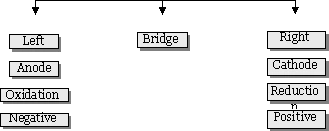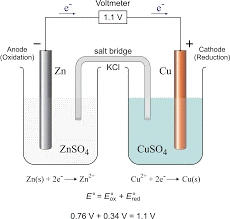Salt Bridge And Representation Of Cell
Salt Bridge
A salt bridge is a gadget used in an electrochemical cell for linking its reduction and oxidation half cells wherein a weak electrolyte is employed. A salt bridge is a junction that bridges the cathodic and anodic sections in a cell.
The salt bridge consists of a strong electrolyte which is additionally comprised of ions. For instance, AgNO3, KCl, and so forth. Salt bridges are commonly used in a galvanic cell.
Salt Bridge Use
The principle function of a salt bridge is to help keep up the electrical neutrality inside the inner circuit of the galvanic cell. It also helps in keeping the cell from taking its reaction to equilibrium. On the off chance that salt bridges are absent or on the off chance that they are not used, at that point, the reaction will probably proceed, and the solution in one-half electrodes will assemble a negative charge. Similarly, in the other half, electrodes would aggregate a positive charge. This will additionally result in the stoppage of the reaction, and no power will be delivered.
Thusly, a salt bridge basically helps in forestalling the gathering of positive and negative charges around the respective electrodes and further permitting a smooth reaction to occur. It also helps in the consistent progression of electrons. Nonetheless, the aim of a salt bridge is not to move electrons from the electrolyte; rather it's to keep up charge balance because the electrons are moving from one-half cell to the next.
Salt bridge prevents the diffusion or mechanical progression of solution starting with one-half cell then onto the next. It prevents or minimizes the fluid intersection potential. Salt bridge behaves as an electrical contact between two half cells.
Representation of an Electrochemical Cell
The cell might be composed by organizing each of the pair left – right, anode – cathode, oxidation – reduction, negative and positive in the in sequential order request as,

Types of Salt Bridges
There are primarily two kinds of salt bridges that are used in electrochemical cells.
• Filter Paper Bridge
• Glass Tube Bridge
Filter Paper Bridge
They are the most used bridge type, consist of porous filter material immersed in the electrolyte. Potassium chloride (KCL) or sodium chloride (NaCl) are typically used electrolyte. Electrolytic concentration, roughness, and porosity of filter paper influence the conductivity. For better conductivity, a filter paper with smooth surface absorbent is used, they give higher conductivity than rough paper with lower absorbent.
As stated over, a salt bridge's principle work is to keep up the electrical impartiality between two vessels, for this, the salt must be inert. The ions must move to and forward between the two half cells. In contrast to different salts, potassium chloride (KCl) and potassium nitrate (KNO3) are better inert salts. An inert salt is used to keep the reactions from happening between the salt and solution. The inert salt potassium chloride is a generally used salt because the potassium and chloride ions have exceptionally regular diffusion coefficient and limiting intersection potential, yet the potassium chloride is unwise to use as electrolyte when the anode used is lead or silver because they form a precipitate.
Related Video:
- The purpose of the salt bridge in a galvanic cell is to
- In a galvanic cell, the positive ions of salt bridge migrate towards
Glass Tube Bridge
They are for the most part U – Shaped Tubes loaded up with electrolyte. Potassium Nitrate (KNO3), Potassium Chloride (KCL), Sodium Chloride (NaCl), is commonly used electrolyte. The electrolyte needs to be moderately unreactive with different chemicals in the cell and have cations and anions with similar transitory speed (tantamount particle charge and sub-atomic weight).
The electrolytes are frequently held as gel such as Agar-Agar. The concentration of salt solution and distance across of the glass tube plays a significant job in conductivity. Bringing down the concentration and the breadth of the cylinder decreases the conductivity.
Salt Bridge in Electrolysis
As in the case of an electrochemical cell, salt bridges possess the same capacity in electrolytic cells as well. If we immerse the two electrodes in a single solution in a single vessel, no salt bridge is necessary, yet on the off chance that we need every terminal in an alternate solution and in separate containers, we need a salt bridge to finish the circuit. It contains ions that go about as charge carriers.
Preparation of Salt Bridge
For setting up a salt bridge, take material that is sufficiently huge to fit in two vessels. Put this material in the electrolytic solution until they get saturated with the solution. Cautiously take the material from the electrolytic solution and discard the excess of electrolyte.
To prepare gel to function as gridge, the gel is suspended in an electrolytic solution, and they are treated with a buffer solution and warmed later. The viscous gel is permitted to set on a glass plate or cylinder.
Functioning of Salt Bridge
The oxidation reactions that happen in the anode terminal generate electron and positive ions. The electrons flow across the wire, leaving the uneven positive charge in a vessel. To keep up the electrical neutrality, the negatively charged (NO3–) ions shifts to the positively charged vessel, i.e. anodic half cell.

A similar condition forms in the cathode cell; however, in the reverse direction. Here the Cu2+ ions are consumed. So for keeping up the electrical neutrality, the K+ ions are migrated into this half cell from the salt bridge. Subsequently, the electrical neutrality of solution is kept up by the salt bridge.
Significance of Salt Bridge in a Galvanic Cell
In a galvanic cell, electricity is produced by a redox reaction. A salt bridge has a significant role in a galvanic cell. In the absence of salt bridge in the galvanic cell, the following things happen:
• The solution in each vessel is electrically neutral, prior to the bridging of wires.
• So they have an equivalent number of negative and positive charges.
• The Zinc rod (anode terminal) will lose 2 electrons. So that the electrons flow to the copper rod (cathode terminal) through the wire.
• So the electrolytic solution gets a positive charge since zinc loses electrons.
• The copper rod accepts the two electrons causing one positive copper particle (Cu+2) to leave the solution and gain two electrons.
• Thereafter, a copper atom will deposit on the copper rod.
• Hence this solution becomes negatively charged.
At this point, there are two voltages, one between the two electrodes and the other is between the charged solutions. The voltage between the metal rods or cathode is positive, and the voltage between the charged solution is negative. So these voltages will counteract each other, and no current flow will happen. Hence, a salt bridge is important for any electrochemical cell or electrolysis.
Important Chapters:


Similar Questions
Knowledge Check
A salt bridge
Aallows the flow of current by completing the electrical circuit.Ballows easy intermixing of the ions in the two half cellsCelimination liquid junction potentialDmaintains the electrical neutrility of the two h alf cells.A salt bridge
Aallows the flow of current by completing the electrical circuitBallows easy intermixing of the lons in the two half cells.Celiminates liquid junction potentialDmaintains the electrical neutrality of the two half cells.
Salt Bridge | Construction of Galvanic Cell | Representation of a Cell
View SolutionDaniel Cell | Salt Bridge | Construction of Galvanic Cell | Representation of a Cell | Nerst Equation Based questions
View SolutionElectrochemistry|Electrochemical Cell|Construction Of Electrochemical Cells|Representation Of Cell|OMR
View SolutionGalvanic Cells |Salt Bridge And Its Functions|Functioning Of Cell When External Opposing Pontential Is Applied|Representation Of Electrochemical Cell|Summary
View SolutionElectrode Potential | Representation of a Cell
View SolutionIntroduction OF Chapter||Types OF Salt|| Simple & Mixed Salt|| Molecular Addition Compound|| Double Salt and Complete Salt|| Representation OF Co-ordination Compounds
View Solution
